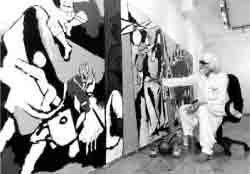COVER
In Solidarity with
Anti-POSCO Movement
 As the Odisha Government went ahead with its plan of forced land grab for the POSCO project, women, children, elders, youth and men of the Dhinkia, Govindpur and other villages of Jagatsinghpur district of Odisha state, in an exemplary display of resistance, lay day after day in the scorching sun face to face with nearly 30 police platoons. Protesting women were beaten up when they tried to prevent police platoons from destroying betel vines. Jagatsinghpur was on the brink of being turned into another Kalinganagar. The movement has now gained a small respite with the Odisha Government putting the land acquisition plans on hold for some days.
As the Odisha Government went ahead with its plan of forced land grab for the POSCO project, women, children, elders, youth and men of the Dhinkia, Govindpur and other villages of Jagatsinghpur district of Odisha state, in an exemplary display of resistance, lay day after day in the scorching sun face to face with nearly 30 police platoons. Protesting women were beaten up when they tried to prevent police platoons from destroying betel vines. Jagatsinghpur was on the brink of being turned into another Kalinganagar. The movement has now gained a small respite with the Odisha Government putting the land acquisition plans on hold for some days.
Below is an excerpt from a statement issued by environmental groups and activists, along with representatives of CPI and CPI(ML), on on 7 June in New Delhi.
POSCO: A scandal far bigger than 2G scam
It is high time the nation’s conscience is affected by what the project affected communities are suffering under the hands of the Navin Patnaik regime in Odisha. It is time to appreciate the fact that the POSCO project is perhaps the most shocking example of corrupt practices legitimised by State support. This is because the project is nothing short of a legalised loot of our natural resources – iron ore in this case. In an unprecedented deal, Indian and Odisha Governments have supported POSCO’s demands to mine 600 million tonnes of the finest iron in India on a 30-year lease. Of this, 30% can be exported for processing in POSCO’s Korean plants and thus endorsing profiteering abroad! With current fine iron ore rates crossing Rs. 8,000/tonne, it is simple arithmetic to note that POSCO can recover its capital investment of Rs. 52,000 crores in less than eight years, an unthinkable proposition in any industrial venture! Truly, the POSCO venture is a scandal far worse than those involving 2G and CWG. 
In fact, A. Raja, principal accused in the 2G scam, may have facilitated POSCO’s entry when as Indian Environment Minister in 2007 he accorded the first major statutory clearance by approving the captive port component, one day before he transited to the Telecom Ministry. This was done without any review and also in response to severe pressure from then Union Finance Minister Chidambaram. Various key environmental and forest clearances quickly followed, all by subverting laws and breaking down the massive industrial/mining venture into little parts to hide their true environmental, social and economic consequences.
Three years later when Jairam Ramesh, the sitting Environment Minister, ordered a comprehensive review of these clearances by setting up two independent investigations, both committees confirmed that the clearances had been secured by fraud and subterfuge, and strongly recommended withdrawal of these illegal approvals. The appropriate action that the Minister should have taken was to cancel these fraudulent clearances and initiate criminal action against all involved in the POSCO decisions.
Instead, Jairam Ramesh claimed he was working towards “cooperative federalism” and on the basis of his “faith and trust” in the Odisha Government approved the project’s environment and CRZ clearances on 31 January 2011 and subsequently the forest clearance on 2nd May. This was despite absolute evidence that the Forest Rights Act had been fundamentally violated by deliberately overlooking Gram Sabha resolutions (convened by the constitutionally empowered Panchayats in the project affected villages) that clearly rejected the project. Ramesh, thus, became a party to the fraud in environmental decision-making and also directly responsible for the dangerous situation that is developing in the POSCO-affected villages today.
We demand that
1. The Odisha Government must immediately withdraw its police operations and forcible acquisition of land for POSCO.
2. The Central Bureau of Investigation must immediately expand the scope of its ongoing investigations against A Raja by reviewing his role in the POSCO clearances, and that of all those who have been involved in illegally promoting this scandalous project, possibly including then Finance Minister and presently Home Minister, Chidambaram.
3. The scandalous POSCO project must be scrapped as its benefits will be accrued mainly by major American financiers (including Warren Buffet) who are major stockholders of this South Korean company.
Tribute
M F Husain
Dharmendra Sushant
Maqbool Fida Husain is no more. He breathed his last on 9 June 2011, exiled from his homeland, in London.
Dragged into controversy by the Hindutva forces in the latter part of his life, he remained, in uncontroversial terms, modern India’s foremost artist, renowned across the world.
Born in 1915, Husain, till the end of his years, retained the energy and enthusiasm of youth. Indira Gandhi’s assassination, Safdar Hashmi’s assassination, Sachin Tendulkar’s rise, personalities like Faiz or Mother Teresa, most recently, the anti-corruption movement – his paintings had the rare ability to comment on a range of contemporary social and political themes. His support for the Emergency, and his painting of Indira Gandhi as the goddess Durga surprised many. But as his friend and fellow artist Krishen Khanna said, “I differed with him on the question of Emergency… but whether you liked him or differed with him, Husain was central to the whole business of modern Indian art.”
Husain was among the first generation of post-Independence Indian artists to make a break with the nationalist or revivalist artistic trends of the past. Along with Souza, Raza, Ara, Gaitonde and Bakre, he too was part of the Progressive Artists’ Group formed in 1947, which was central in shaping the post-Independence artistic milieu.
With a distinctly modern idiom and sensibility, Husain retained deep links with India’s artistic traditions. But he was never parochial in the name of India or Indianness. As an artist, the whole world was his canvas. He is one of the few painters to have depicted Indian epics and myths in a modern context.
The attack by the saffron mobs on him was entirely political. His Muslim origin was the sole reason for being targeted by the Sangh Parivar. Scores of cases were slapped on him in an attempt to victimize and harass him. One Hardwar court ordered his property to be confiscated and another in Indore issued a non-bailable warrant. The Supreme Court later, in a welcome judgement, put an end to the legal harassment. In India and even once in London, his exhibitions were cancelled because of attacks by Hindutva mobs.
After his death, Prime Minister Manmohan Singh declared it to be a “national loss.” But it was the UPA Government’s former Home Minister Shivraj Patil who had, in 2006, instructed the police in Delhi and Mumbai to take action against Husain on the grounds that his paintings could spark off communal trouble! The ‘secular’ Congress-UPA government at the Centre thus pandered to the communal fascists – and this is what eventually forced Husain into exile, and he took the Qatari nationality offered to him.
Husain’s story reminds us of the shadow of communal fascism that hovers over India’s democracy. Husain’s paintings never commented on these forces; he just quietly continued to paint in freedom.
In his final interview, Husain expressed the wish to spend his last days in his own country – a last wish that could not be fulfilled. This is a matter of shame and anguish for all those in India who love art and who care for freedom.
Liberation expresses heartfelt farewell to this great Indian artist!
 As the Odisha Government went ahead with its plan of forced land grab for the POSCO project, women, children, elders, youth and men of the Dhinkia, Govindpur and other villages of Jagatsinghpur district of Odisha state, in an exemplary display of resistance, lay day after day in the scorching sun face to face with nearly 30 police platoons. Protesting women were beaten up when they tried to prevent police platoons from destroying betel vines. Jagatsinghpur was on the brink of being turned into another Kalinganagar. The movement has now gained a small respite with the Odisha Government putting the land acquisition plans on hold for some days.
As the Odisha Government went ahead with its plan of forced land grab for the POSCO project, women, children, elders, youth and men of the Dhinkia, Govindpur and other villages of Jagatsinghpur district of Odisha state, in an exemplary display of resistance, lay day after day in the scorching sun face to face with nearly 30 police platoons. Protesting women were beaten up when they tried to prevent police platoons from destroying betel vines. Jagatsinghpur was on the brink of being turned into another Kalinganagar. The movement has now gained a small respite with the Odisha Government putting the land acquisition plans on hold for some days. 

